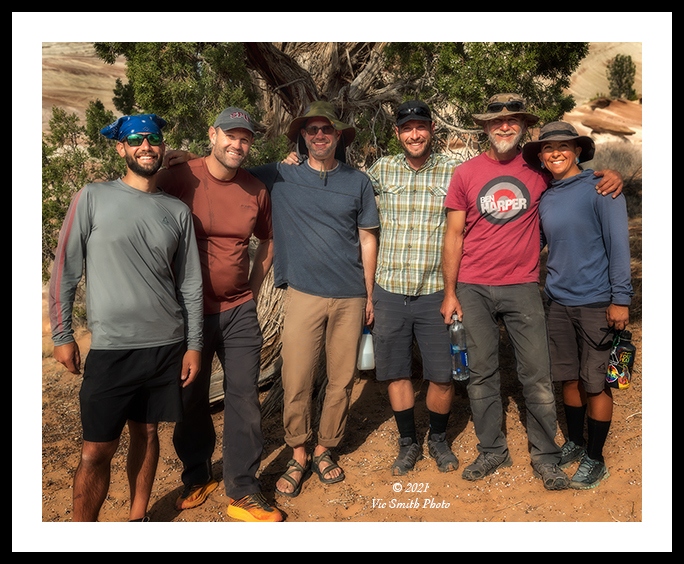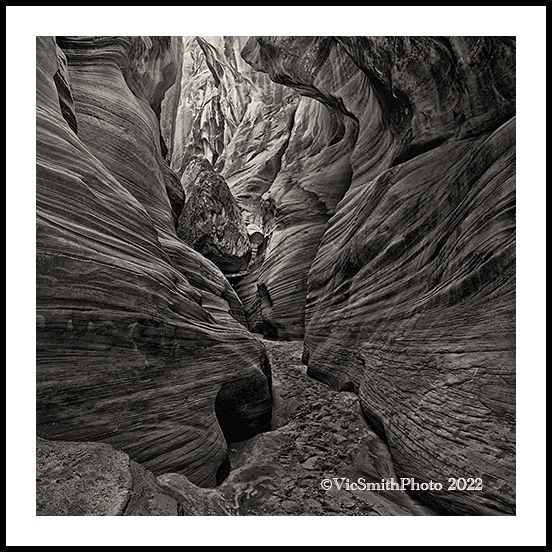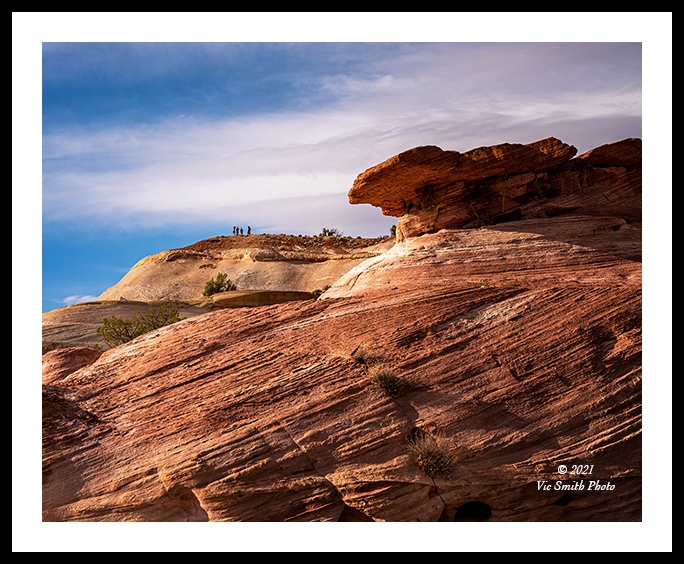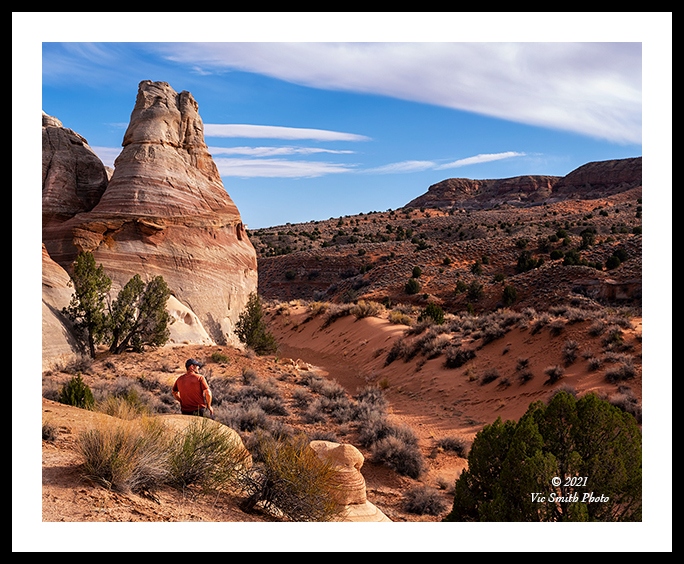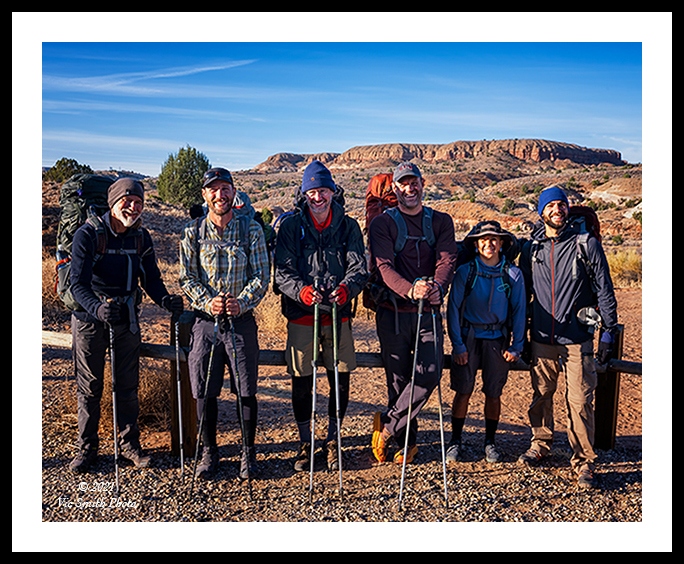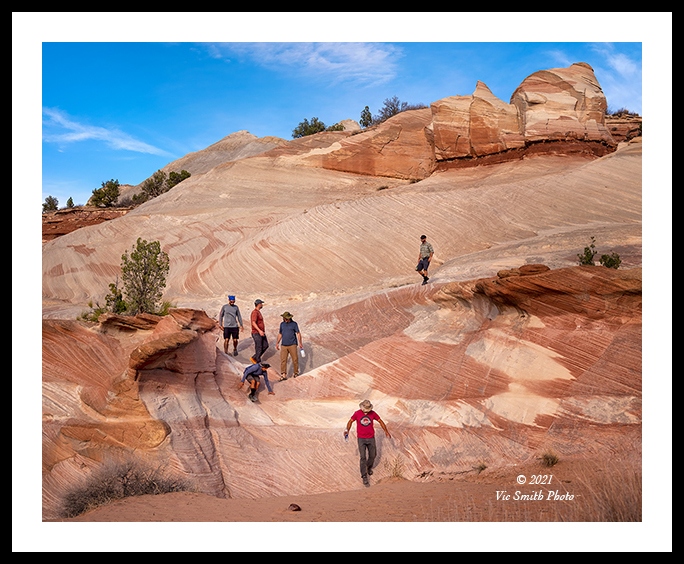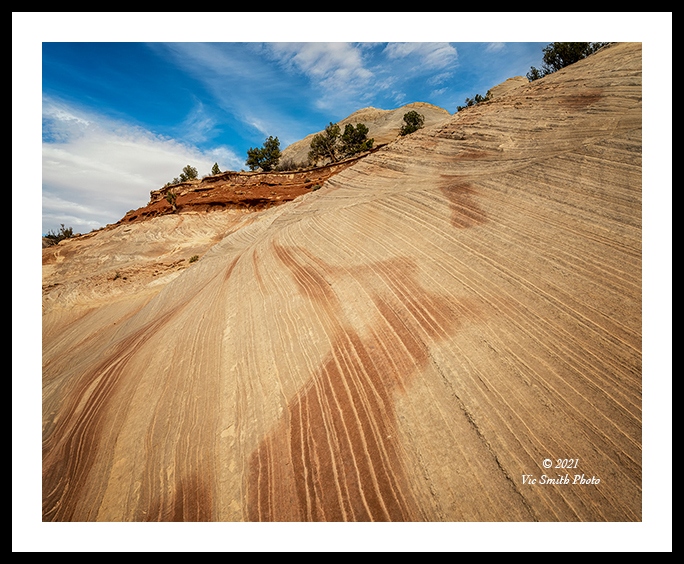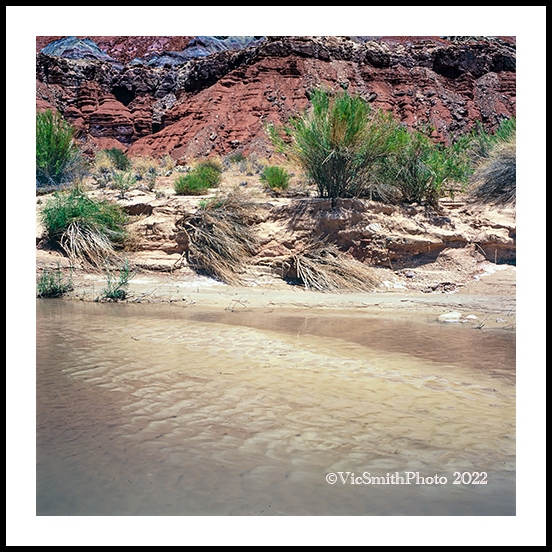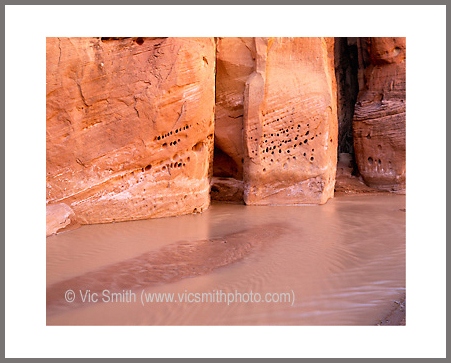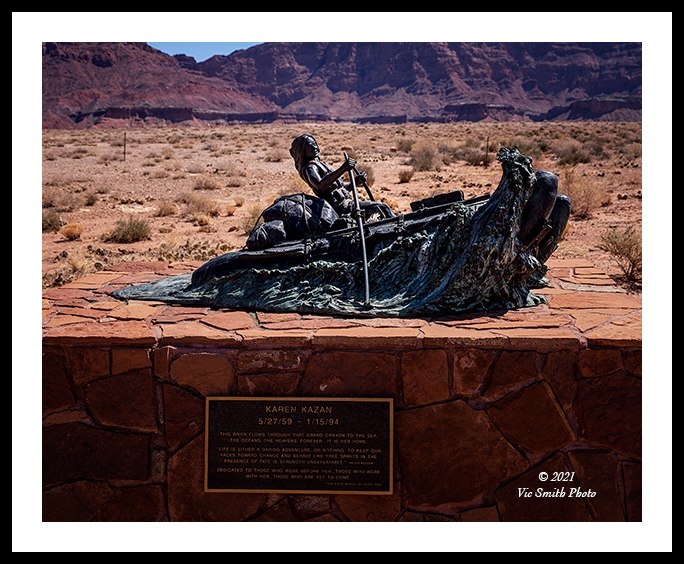Night was lifting at the White House Trailhead. Lights were popping up in tents and vehicles around the circular drive. I rose from my simple camper platform to the desert crispness. Not far away my son, Matthew, and five of his mates (Mitch, Joe, Jared, Mary Ann, and Pat) were stumbling from their tents.
We were all perched a bit above the trace of a river, the Paria. I smiled, remembering yesterday’s traverses with Matthew across the rich reds, oranges, creamy whites, and browns of the pillowed sandstone hills around us, searching for glimpses of the iconic, my hands feeling the sand crystals. The mates, being immortal, had hiked up, to the top of the pillows, becoming stick figures against the blue sky. Then a popping campfire drew us together, to eat tasty pasta, drink gifted Rye Whiskey, light a joint or two, talk about new equipment, recount past times, and complain about clients calling that afternoon to request meetings (aargh). I listened and enjoyed it all.
The river was the focus of our gathering. It had drawn Matthew here more than 12 times. I’d joined once, 10 years ago, but I’d always tried to meet up with him at his entry.
“Paria” is “Muddy water”, a name gifted from the indigenous people of the area, the Southern Paiute. They’ve lived on this land, much of southern Utah down to the Grand Canyon, for over twelve millennia, charged by Creator to care for and prosper upon.
The Paria starts further north in this swath, below what we now call Bryce Canyon, what they call “Red Painted Faces” (each label has a story, for another time). The flow starts below the Faces, the 50 million year old red limestone towers, picking up slick brownish green bentonite clay from volcanic ash. It then flows south, past our camp, and disappears after 95 miles in the Paria Riffle in the Colorado (spanish for “reddish”) River.
On its way south it carves a wet path, through and then below 200 million year old sandstone landscapes, dunes and deltas that once hosted dinosaurs, now stacked one on the other in earth that we label as “Vermilion” (also borrowed from the Southern Paiute) Cliffs.
This land seems new when you look at the elite camping vans and the optimized equipment and provisions of hikers. But it is at its core ancient land of an ancient people, all part of a Grand Staircase.
Breakfast completed, packs stuffed, a last photo taken, the fellowship started downriver, laughing, joking, prodding, 4 days, 3 nights, 38 miles, they would be in the slick, muddy, shoe-sucking water, then by the water, around the water, crossing the water dozens of times, and rising from the water to deep sand to cross water yet again.
I would head home. But I would use my memories to imagine the splendor they would be seeing.
The first landmark I remembered was the Narrows, White Navajo Sandstone (like in Zion) lithified dunes rising up to infinity, 3 football fields high, sometimes just 6 feet apart. These cathedral walls are only interrupted by the Buckskin Gulch, a water-carved ditch 12 miles long (the longest slot canyon in the world). I remembered walking through them, feet in watery, sloppy mud, worried about hidden rocks and surprise quicksand, wind in my face, bats zipping past, commuting out from their caves for a night’s feeding.
How did such big pillows get carved? In soft sandstone, water works its relentless magic, breaking apart crystals. The Paria flow is less than 10 cubic feet per second(cfs). But periodically nature unleashes its power, sending ravaging flash floods down river. In 1998 one flood delivered 6500 cfs of water, sand, mud, trees, sending 800,000 tons of sand to the Colorado. In 1925, 16,000 cfs roared down.
Beyond the narrows, wide spaces appeared. Western water flowing through a riparian wonder in a harsh desert always attracts humans seeking to prosper. Adams Pasture and the trail down to it ends at Big Spring. Wrather Canyon lies a bit further on and leads south, up to Wrather Arch, a cave natural arch, nearly 200 feet long and looking from above a bit like a giant turtle grazing on the foliage. Nearer the end of the canyon, Wilson Ranch is now abandoned. Humans came and now are gone. The land has been returned.
Paria Canyon today is less trammeled, tightly managed to protect some level of wildness for recreational purposes, with strict entrance limits and Leave No Trace Enforcement. It is a tiny slice of wildness[ Vic Smith 4/18/21, 6:25 AM Can we really stop the wild? There are ravens everywhere. There are coyotes in the middle of our towns. There are falcons nesting on high rises.] (if that’s possible), remote, with webs of life, a bit of a haven, in a sea of modernity:
…Bats, beavers, birds, bobcats, cougars, coyotes, porcupines, snakes, skunks, insects…
…Cattails, willow, cottonwood, rabbitbrush, indian rice grass…
The infinite is impossible to avoid in the remote space of the canyon. Jet Contrails are distant. Helicopters are rare. Cell towers won’t reach in again until the ride home. The canyon is narrow, the path is narrow, but I remember stopping to rest on a rock, seeing green cottonwoods flutter in the distance or a red-tailed hawk circle overhead, feeling the infinite bust out. Time slowed and the rest of the world moved away, sighs emerged.
Solitude is refreshing. Loneliness in a remote, hostile place can be dangerous. Once I had entered the canyon, the only real exit would be at the end, unless an emergency beacon were activated (we didn’t have one). Flash floods, disorientation, slips, falls, cuts, animal encounters, sudden sickness, and physical limitations tested endurance. The last water source was 11 miles from the end, just before the final desert trek.
And then the end appeared, a mirage? The trail became a road. The cars, with much-anticipated refreshments were nearly in sight, but there was still a mile to go; water was low, joints ached, the longest mile. Then, the celebration.
All words and images on this site are © VicSmithPhoto 2021
